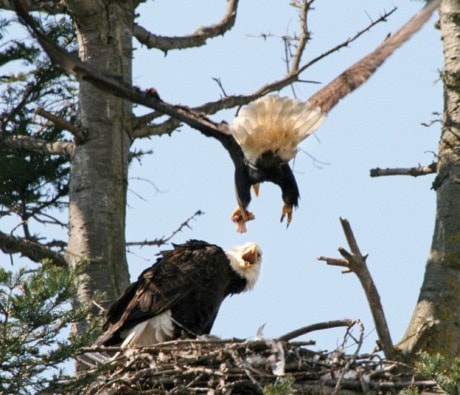Bald eagles have long been one of the most recognizable birds in North America.
Their iconic white heads have graced everything from flags to stamps to sports and business logos, and they are perhaps most famously known as an official symbol of the United States.
Oak Bay, with its abundance of shoreline, provides ideal habitat for the big predators. Observers have had their eagle eyes trained on a trio of local nests for several years now.
The nests, located behind the fire hall on Monterey Avenue, on the grounds of the Victoria Golf Club and in Anderson Hill Park, have attracted a loyal following.
“I was never a birder until I found the eagles,” said Kay Steer, who lives in Saanich, but frequently comes to Oak Bay to check on her feathered friends.
She visits a number of eagle nests throughout the Capital Region, but the accessibility of the ones in Oak Bay makes them prime photo subjects. “They’re just so beautiful with their white heads.”
According to mainland-based wildlife biologist David Hancock, bald eagles generally mate for life and their tendency to return to the same nest, year after year, creates a bond between the birds and those who watch them.
“In a sense, what we’ve developed is kind of a guardian of wildlife,” he said. “Some of them know every movement of every bird.”
Hancock’s eponymous Wildlife Foundation is involved in a number of conservation initiatives, but it’s perhaps best known for installing web cams in several eagle nests on Vancouver Island and the Lower Mainland.
Currently none of the Oak Bay nests are video monitored, but Hancock said if he can secure the help of a sponsor, that could change.
At the Victoria Golf Club, duffers seeking out eagles of the two-under-par variety may have better luck spotting the real thing. The birds at the club have been nesting there for at least a decade, according to club employees, and have become quite popular with the golfers.
“Our members look for them every spring,” said general manager Scott Kolb. “They just add another unique feature to our golf club.”
He reminds members of the public who want to watch the birds to do so from outside the course boundaries, to avoid being injured by errant golf balls or other hazards around the property.
The easiest of the three nests to get up close and personal with is the one behind the Oak Bay fire hall.
The eagles there suffered some kind of trauma – likely the theft of their eggs by a marauding raven or raccoon – and temporarily abandoned the nest last year. This spring they returned and what’s more, they’ve added a pair of eaglets to the family.
“It’s quite exciting to see the chicks growing up and popping up above the nest,” said Oak Bay Fire Chief Gerry Adam. “You hear them squawking and chirping all the time.”
It’s a rare day that someone isn’t spotted outside the hall with a pair of binoculars or a camera, he added.
The third nest, next to an Island Road house, is not quite as accessible as the other two.
However, the eagles that live there have a favourite perching tree at the south end of Anderson Hill Park which is much more visible.
The male is also often spotted sitting on a marker on Trial Island.
For Steer, the eagles have almost become extended family members.
“You get to know them so well when you’re watching them,” she said.
Steer and her fellow eagle-watchers – of which there are dozens – share photos and document the birds’ movements on the Hancock Wildlife Foundation website, which has forums dedicated to many different animals. Visit www.hancockwildlife.org to learn more about local eagles and other projects.
editor@oakbaynews.com
